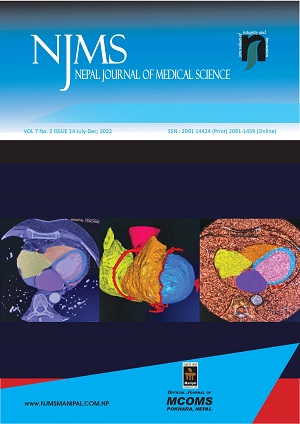Intra and Interobserver Reliability of Optic Nerve Sheath Diameter in Normal Nepalese Adults using Transorbital Ultrasound
DOI:
https://doi.org/10.3126/njms.v7i2.47235Keywords:
Intracranial Pressure, Observer Variation, Optic NerveAbstract
Introduction: Transorbital sonographic measured optic nerve sheath diameter (ONSD) has turned into a promising screening and monitoring tool lately. Nonetheless, the test qualities of this procedure require to be addressed to be feasible to use in clinical practice. This study aims to assess the intra and interobserver reliability of transorbital ultrasound.
Methods: A prospective observational study was conducted on 37 healthy adults. Three serial ONSD of both the eyes were measured using ultrasound by two investigators independently.
Results: The age of the participants ranged from 20 to 30 years with a mean age of 23.86 ± 2.35 years with 54.1% male and 17 45.9% female. The mean ONSD of both eyes was 4.15 ± 0.38 mm for investigator 1 and 4.11 ± 0.37 mm for investigator 2. The mean ONSD of the two investigators was 4.13 ± 0.37 mm with a mean difference of -0.036 ± 0.118 mm (at 95% confidence interval, -0.003 - 0.075 mm). For intra-observer reliability, Intraclass correlation analysis for investigator 1 showed 0.995 for the right eye and 0.995 for the left eye and investigator 2 showed 0.993 for the right eye and 0.997 for the left eye. Interobserver intraclass correlation analysis showed 0.973. In addition, Bland-Altman plots were drawn to see the interobserver limit of agreement using mean ONSD (4.13 ± 0.37 mm) and mean difference (-0.036 ± 0.118) of two investigators.
Conclusion: Measurement of ONSD by transorbital ultrasound is a feasible method to assess intracranial pressure noninvasively with high intra and interobserver agreement.
Downloads
Downloads
Published
How to Cite
Issue
Section
License
Copyright (c) 2022 Nepal Journal of Medical Sciences

This work is licensed under a Creative Commons Attribution 4.0 International License.
Copyright © by Nepal Journal of Medical Sciences. The ideas and opinions expressed by authors of articles summarized, quoted, or published in full text in this Journal represents only opinions of authors and do not necessarily reflect the official policy of Nepal Journal of Medical Sciences or the institute with which the author(s) is (are) affiliated, unless so specified.




